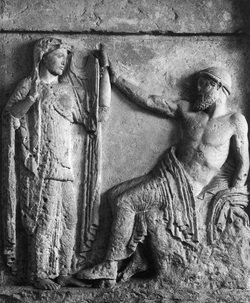Women's Olympics: The Heraen

The Heraen games was a women's sports event founded by Queen Hippodameia. The Heraen occurred every 4 years and became, centuries later, the model for the Olympics. It continued until surpressed in the Christian era for its pagan associations. Foot races were the first and central event, but there is evidence as well that the event included chariot races, javelin toss and nude wrestling (activities regulated specifically for Spartiate women who competed in intersex sports and trained with their male counterparts as well).
"The ancient Heraean Games, dedicated to the goddess Hera (also spelled Heraia) were the first sanctioned (and recorded) women's athletic competition to be held in the stadium at Olympia,[1] possibly in the Olympic year, prior to the men's events. It is dated as early as the 6th century BC. Some texts, including Pausanias's Description of Greece,[2] c. 175 AD, state that Hippodameia gathered a group known as the "Sixteen Women" and madetrators of the Heraea Games, out of gratitude for her marriage to Pelops.[3] Other texts indicate that the "Sixteen Women" were peace-makers from Pisa and Elis and, because of their political competence, became administrators of the Heraea Games."[wiki.quote]
During the competition, the women competitors would clothe themselves as men.
"A Delphi 1st century AD inscription tells that two young women competed in races (not the Olympics), possibly in women's races at the Sebasta festival in Naples (during the imperial period) and in Domitian's races for women at the Capitoline Games in Rome, 86 AD.[3]"
Recorded competitors of the Heraen and Olympics, would be the Spartiate women Cynisca-a daughter of Spartan nobility. She won the chariot race of the Olympics, in 4th century B.C. Cynisca's brother had dared her to enter the games, believing her victory would undermine the games' importance to the Greeks. Considering that it was criminal and punishable by death for a woman to participate in the Olympic games, or to even be seen in attendance.
Another attendee and female participant of the Olympics, was Bilistiche. A Hellenistic courtesan, the Hetaera of Ptolemy Philadelphus, as well as a horsebreeder. Her steeds were famous in the Olympiad. After the success of Cynisca-the first female victrix of the chariot races-many women became active participants. Bilistiche from Ionia appears to have been one of those early victrices. Winning the 4-horse chariot race in 268 B.C and in 264 B.C. A few scholars wonder if the several names of female charioteers weren't merely breeders whose horses were raced by men. Yet, there is ample evidence of women typically racing chariots under a variety of circumstances-at festivals fo Hera (also under the Heraen games). Bilistiche was made a goddess upon her death as Aphrodite Bilistiche.
"The ancient Heraean Games, dedicated to the goddess Hera (also spelled Heraia) were the first sanctioned (and recorded) women's athletic competition to be held in the stadium at Olympia,[1] possibly in the Olympic year, prior to the men's events. It is dated as early as the 6th century BC. Some texts, including Pausanias's Description of Greece,[2] c. 175 AD, state that Hippodameia gathered a group known as the "Sixteen Women" and madetrators of the Heraea Games, out of gratitude for her marriage to Pelops.[3] Other texts indicate that the "Sixteen Women" were peace-makers from Pisa and Elis and, because of their political competence, became administrators of the Heraea Games."[wiki.quote]
During the competition, the women competitors would clothe themselves as men.
"A Delphi 1st century AD inscription tells that two young women competed in races (not the Olympics), possibly in women's races at the Sebasta festival in Naples (during the imperial period) and in Domitian's races for women at the Capitoline Games in Rome, 86 AD.[3]"
Recorded competitors of the Heraen and Olympics, would be the Spartiate women Cynisca-a daughter of Spartan nobility. She won the chariot race of the Olympics, in 4th century B.C. Cynisca's brother had dared her to enter the games, believing her victory would undermine the games' importance to the Greeks. Considering that it was criminal and punishable by death for a woman to participate in the Olympic games, or to even be seen in attendance.
Another attendee and female participant of the Olympics, was Bilistiche. A Hellenistic courtesan, the Hetaera of Ptolemy Philadelphus, as well as a horsebreeder. Her steeds were famous in the Olympiad. After the success of Cynisca-the first female victrix of the chariot races-many women became active participants. Bilistiche from Ionia appears to have been one of those early victrices. Winning the 4-horse chariot race in 268 B.C and in 264 B.C. A few scholars wonder if the several names of female charioteers weren't merely breeders whose horses were raced by men. Yet, there is ample evidence of women typically racing chariots under a variety of circumstances-at festivals fo Hera (also under the Heraen games). Bilistiche was made a goddess upon her death as Aphrodite Bilistiche.
